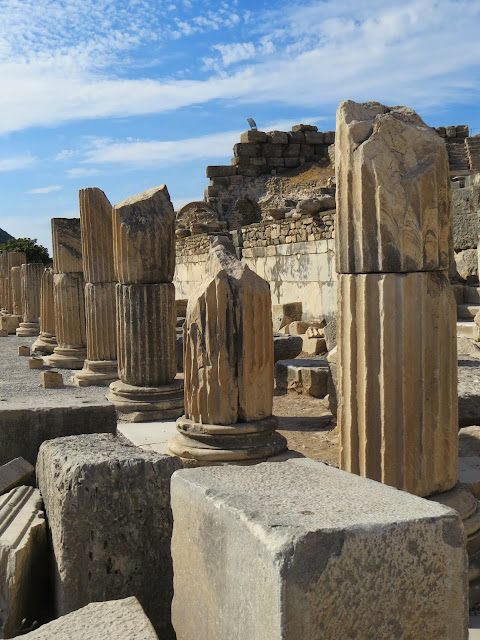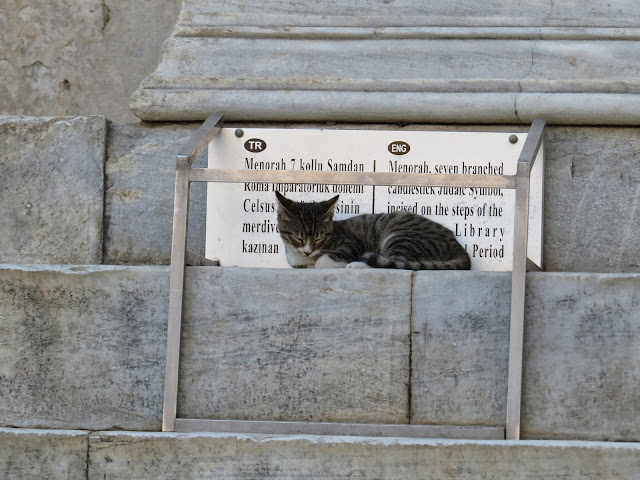The students prepare for their lecture.
We had delightful tea, coffee and cake after the lecture in a charming garden.
We had been to Ephesus on our trip 15 years ago, and took a tour with friends. At that time it was a shadow of what it is now. We remember a site to the side of the main road of the ruins that was covered in tents and closed to the public. Our friends, who stayed on for few months on their sailboat, met the archaeologists who were working there, and got a private tour. They told us that it was a dig of private homes rather that public buildings, and a real addition to the sense of the city.
Our visit this time was even more detailed, and included the private homes. It was well worth the second visit.
The area around Ephesus was inhabited by 6000 BC. The city could have been founded by the Hittites as early as 1400 BC. Some say it was founded by Amazons. The legend today is that the King of Athens consulted an oracle about where to found a new city, and the oracle told him that the place would be indicated by a fish and a boar. When his scouts were grilling fish for dinner a board jumped out of a nearby bush -- voila.
Ephesus was a seaport, although the sea is now about 15 miles away. The silting up of the bay may be one reason it was ultimately abandoned. We have read and been told that the population at its height was 250,000. Its people were progressive and cosmopolitan, integrating waves of immigrants, promoting women's rights, and emphasizing education.
Our first glimpse of Ephesus was from the bus the day before, as we sped by on our way to our hotel. We could see the theater, by far the largest structure in Ephesus, which would be the last stop on our walking tour today.
This is the Odeon, a small theater seating around 1500 people.
The tour itself began at the top of Curetes Street, the main road of the city.
We saw all types of column capitals.
The columns were topped with statues, probably painted.
There may have been cats in Ephesus in ancient times; there are many there now.
Hadrian's Temple.
This was part of a public bath house.
Any self-respecting bath house has to have toilets.
Marble Street. The slightly raised curb on the sides of the street is part of the underground sewage system.
This the the famous library of Celsus, which once held 12,000 scrolls.
The row of storerooms where merchants stored their goods.
Graffito...what does it mean? Some say it is an ad pointing the way to the brothel. Others say it is a sign to early Christians pointing the way to a church or hospitality.
The library from beyond the gate.
The theater, seating 24,000, believed to be the largest in the ancient world.
Below is the stage of the theater, which would have been enclosed.
The hillside excavation site of the aristocratic homes was an experience as dramatic as the public buildings and streets of Ephesus itself.
The houses were for wealthy people, and seem to have been built abutting each other into the hillside. They are wo well preserved, if that is the word, and so detailed, that archaeologists can tell which were the children's bedrooms. They can also trace the eventual decline of circumstances of the city, as the large elegant homes were broken down into smaller, less upscale dwellings. We could see many architectural details including mosaic floors, marble faced walls, frescoes, and decorative carvings. A feast for the imagination!
Speaking of imagination, consider sitting all those scraps of marble together, without a photo on the box lid.
This room was faced in thin marble of various colors and veins. The tables are filled with bits to be fitted together. The columns on the walls appear to be purely decorative. Note their diffrent capitals below.
And you know, a corner? No worries!
The houses had a water and sewage system; there was a toilet in a small room just as we have today.
The walls were decorated with frescoes which sometimes indicate the use of the room. Note the bird on the back wall.
This room is remarkable for its floor -- a mosaic lion.
A child's room.
This is more than one house, with the richer folks closer to the camera, highest on the hill, and the slightly less rich folks downhill and closer to the street. But, they were all rich. Note the variety of mosaic floor designs.
We'll need to visit in another 15 years to see what else they find!

















































































No comments:
Post a Comment